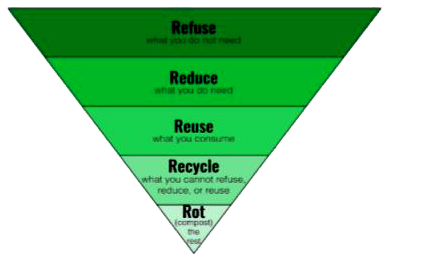Apparatus: Two plastic bottles, measuring cylinder, thermometer, etc
Chemicals: Potassium nitrate, sodium hydroxide, water, etc.
(Sodium hydroxide being corrosive, handle it carefully in presence of teacher.)
Procedure: Take I 00 mL water in each of the two plastic bottles. Plastic being insulator of heat, the dissipation of heat can be prevented. Note the temperature of water in the bottles. Put 5 g potassium nitrate (KNO3) in the bottle and shake well. Note the temperature of the solution formed. Put 5 g sodium hydroxide (NaOH) in the other bottle. Shake the bottle well. Note the temperature.
In the first bottle, the process of dissolution of potassium nitrate took place while in the second bottle, the process of dissolution of sodium hydroxide took place
As per your observation which one is exothermic process and which is an endothermic process? Solution in Marathi
The process of dissolution of KNO3 in water is endothermic while the process of dissolution of NaOH in water is exothermic process.
Topper's Solved these Questions
- CHEMICAL REACTIONS AND EQUATIONSBOOK - TARGET PUBLICATIONCHAPTER - CHEMICAL REACTIONS AND EQUATIONSEXERCISE - Chapter Assessment
31 Videos
- CHEMICAL REACTIONS AND EQUATIONSBOOK - TARGET PUBLICATIONCHAPTER - CHEMICAL REACTIONS AND EQUATIONSEXERCISE - Questions based on paragraph
20 Videos
- CARBON COMPOUNDSBOOK - TARGET PUBLICATIONCHAPTER - CARBON COMPOUNDSEXERCISE - Chapter Assessment(Give scientific reasons.)
3 Videos
- METALLURGYBOOK - TARGET PUBLICATIONCHAPTER - METALLURGYEXERCISE - CHAPTER ASSESSMENT
12 Videos
Similar Questions
The chemical formula of the rust is
View SolutionVeena observes that during winter setting of milk into curd takes more time while during summer, the same process happens faster. She asks about this difference in time taken to her elder sister. She also asks her sister about why certain reactions occur rapidly while others occur slowly. Her sister explains her about the various factors that affect the rate of chemical reactions. Based on the above scenario, answer the following questions.
Why do you think setting of curd occur at different rates during different seasons?
View SolutionState whether the following statements are true or false. If false then rewrite the correct statements: Carbon is tetravalent and it can undergo catenation.
View SolutionA student added zinc strip to a solution of CuSO4. After several minutes, he observed that the blue colour of solution changed and a layer got deposited on zinc strip. The colour of the solution and that of the coating would respectively be ______
View SolutionA student takes 1 g of sodium hydroxide. He adds it to 50 mL of water taken in a plastic bottle and shakes the content well. Which of the following observation is correct?
View SolutionApparatus: Two plastic bottles, measuring cylinder, thermometer, etc
Chemicals: Potassium nitrate, sodium hydroxide, water, etc.
(Sodium hydroxide being corrosive, handle it carefully in presence of teacher.)
Procedure: Take I 00 mL water in each of the two plastic bottles. Plastic being insulator of heat, the dissipation of heat can be prevented. Note the temperature of water in the bottles. Put 5 g potassium nitrate (KNO3) in the bottle and shake well. Note the temperature of the solution formed. Put 5 g sodium hydroxide (NaOH) in the other bottle. Shake the bottle well. Note the temperature.
In the first bottle, the process of dissolution of potassium nitrate took place while in the second bottle, the process of dissolution of sodium hydroxide took place
As per your observation which one is exothermic process and which is an endothermic process?
View SolutionA student takes 1 g of sodium hydroxide. He adds it to 50 mL of water taken in a plastic bottle and shakes the content well. Which of the following observation is correct?
View SolutionApparatus: Two plastic bottles, measuring cylinder, thermometer, etc
Chemicals: Potassium nitrate, sodium hydroxide, water, etc.
(Sodium hydroxide being corrosive, handle it carefully in presence of teacher.)
Procedure: Take I 00 mL water in each of the two plastic bottles. Plastic being insulator of heat, the dissipation of heat can be prevented. Note the temperature of water in the bottles. Put 5 g potassium nitrate (KNO3) in the bottle and shake well. Note the temperature of the solution formed. Put 5 g sodium hydroxide (NaOH) in the other bottle. Shake the bottle well. Note the temperature.
In the first bottle, the process of dissolution of potassium nitrate took place while in the second bottle, the process of dissolution of sodium hydroxide took place
As per your observation which one is exothermic process and which is an endothermic process?
View Solutionপ্লাস্টিক ব্যাগ , বােতল ইত্যাদি যেখানে - সেখানে ফেলা — এটি অভিপ্রেত না অনভিপ্রেত ঘটনা ?
View Solutionপ্লাস্টিকের বোতল কী কাজে লাগানাে যেতে পারে ?
View SolutionA student takes 1 g of sodium hydroxide. He adds it to 50 mL of water taken in a plastic bottle and shakes the content well. Which of the following observation is correct?
View Solutionडी०डी०टी०, प्लास्टिक के थैले एवं बोतलें, अपमार्जक, रंग आदि ...... अपशिष्ट है |
View Solutionपॉलीथीन की थैलियाँ, प्लास्टिक की चूड़ियाँ एवं बोतलें आदि ______ अपशिष्ट हैI
View Solution
When recycling a plastic water bottle, what should you do with the cap?
View SolutionWhy does hot water deform plastic bottles?
View Solution
